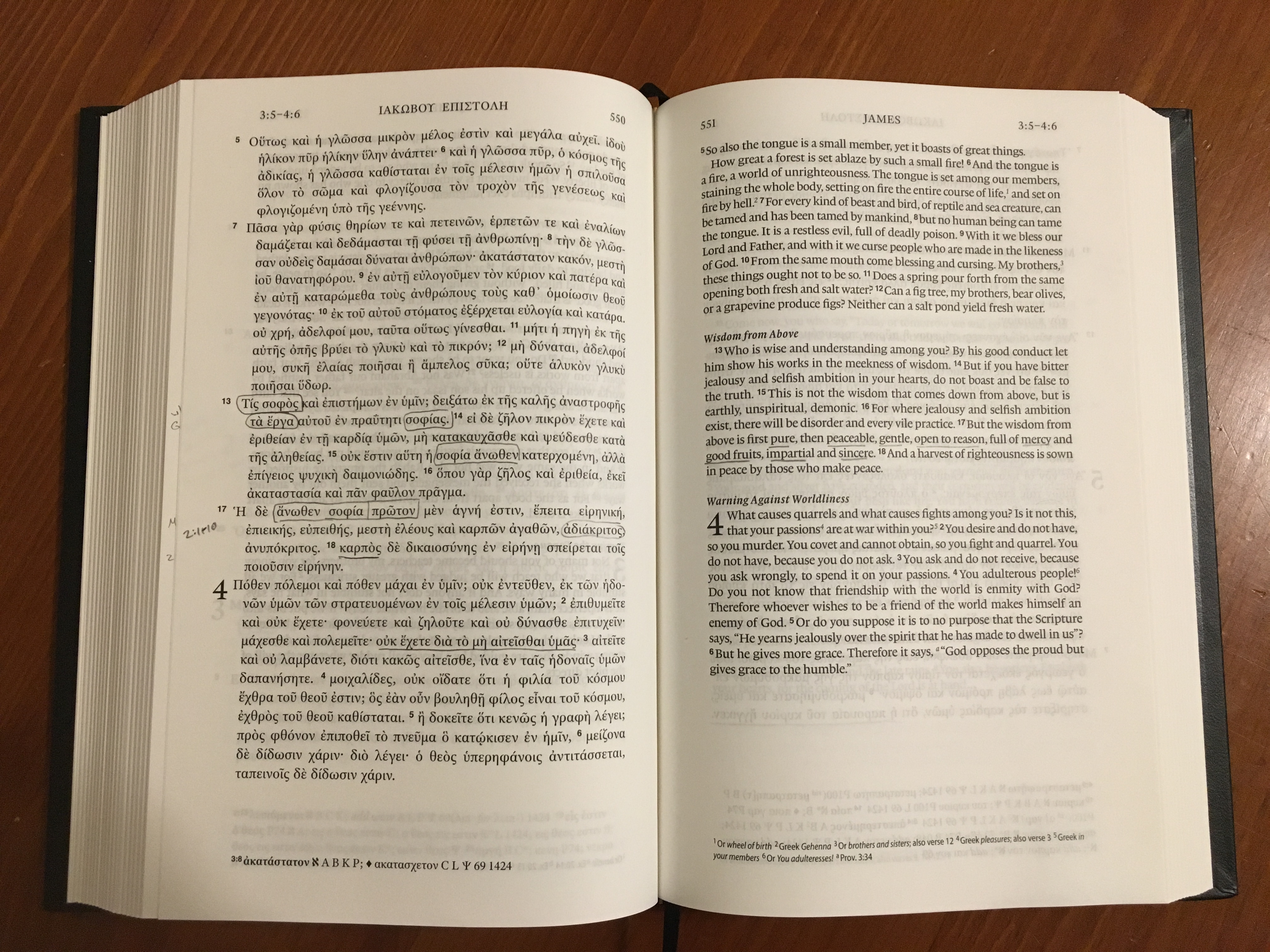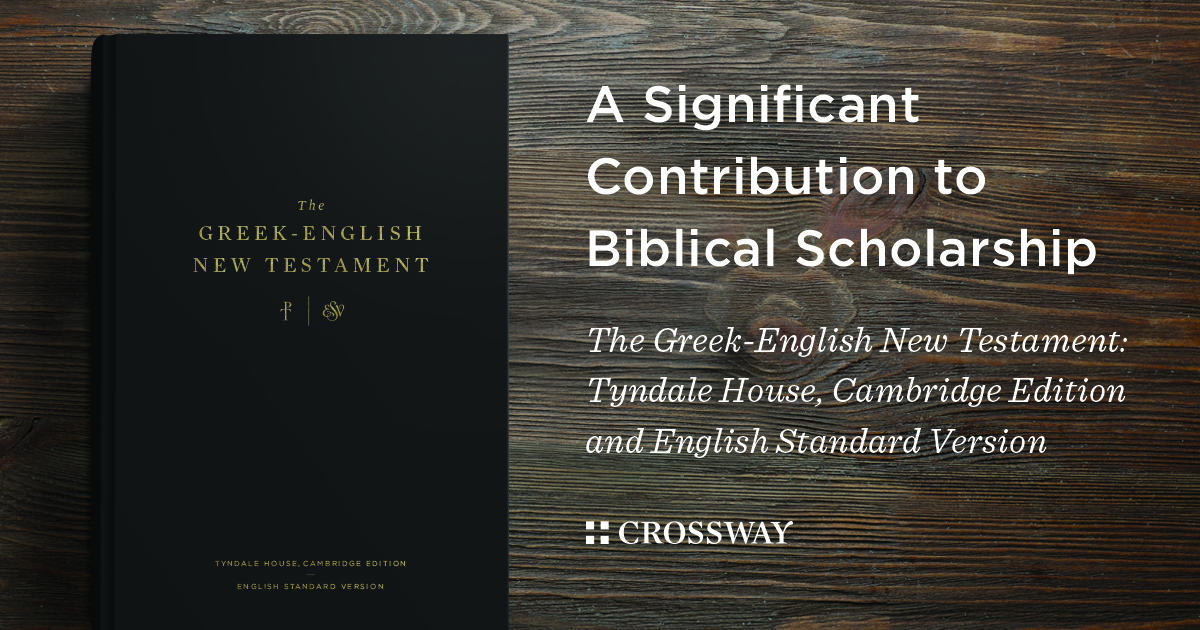I dare say that no Greek-English parallel Bible has been able to win my favor over my 2001 RSV-NA27 imitation leather edition… until now.
Predecessors
I’ve written before about how important it is to choose the right Bible in order to keep up with your Greek. You can choose a reader Bible, which is all Greek but gives glosses for less-common words, a plain Greek Bible, which requires a dictionary and a grammar as aids, or you can choose a Greek-English parallel. While I’ve said that you will learn Greek best if you use (daily!) the plain Greek Bible with external aids, the fact is that we cannot always devote ourselves to a foreign language daily. That’s why I most commonly read the New Testament in a Greek-English parallel.
Until now, I’ve used my trusted sidekick, a very old RSV-NA27 parallel Bible. First published in 1981, it reached its 9th rev. ed. in 2001. Why use such an old Bible? The antiquity of the RSV and the outdated NA edition should suggest to you that I really like this Bible. I have kept using it because (1) it contains the NA27 apparatus with a fully translated apparatus on the RSV side, and (2) it is a wonderfully small size made possible by the reasonably smaller font size. It is a little chunky, though, and its font isn’t the most attractive, especially the italicized Greek font, which looks atrocious.
In 2012, Crossway put out an ESV-NA28 parallel. Since I use the ESV as my primarily English translation, I was excited to finally update from my RSV-NA27–an update on both sides. But alas, the font size was huge! The trim size is about 6.5×9 and it’s still 1,700 pages. I am thankful to own it as my only NA28 apparatus, and I’m sure those with poorer eyesight will be very thankful for the large-print edition to keep at their desk, but this was not a Bible I wanted to carry around and read daily.
Then in 2017, Crossway broke new ground by publishing the Tyndale House Greek New Testament, which now provides competition for NA28 and UBS5. We’ve published a lot on the THGNT, including an overview, a podcast discussing its text-critical methodology, a post explaining different text-critical approaches, and an illustration of the usefulness of the THGNT apparatus with reference to Jude 5.
And now in 2020, they’ve published a new parallel New Testament, with the THGNT on one side and the ESV on the other.
My New Favorite Parallel NT
The THGNT-ESV parallel ticks most of my boxes, which first and foremost include a smaller font size, which allows for a smaller trim size and page-count. As you can see, the Bible is quite small, travels well, and is actually thinner than my previously favored RSV-NA27!

Secondly, as you can see the image below, the line height on the Greek text is more spacious than other Greek editions, which allows for more note-taking and markings in the Greek text.

Thirdly, as I said, the ESV is currently my preferred English translation, so this parallel Bible appeals to me. The biggest rival to the THGNT-ESV is probably the NIV-UBS5 published by Zondervan in 2015. It has a similar font size but a smaller trim size, making it an unfortunately chunky little monster to slip into a bag. I much prefer the ergonomics of Crossway’s new edition. In fact, it even comes in the slick case, which comes in handy when you want to travel with it and keep the pages from getting crinkled or ripped.

Drawbacks
Why wouldn’t you want the THGNT-ESV? One drawback is the lack of cross-references in the ESV text and the lack of OT quotations and allusions that one would find in the margin of NA28. The latter is more important, but one can compensate for this by making your own notations of quotations and allusions as you come across them. This will help to solidify those in your mind, and also to impress upon you the importance of the OT for the NT authors.
Secondly, the THGNT has a more limited apparatus than the NA28. If you are doing in-depth text-critical research, you’ll want something besides the THGNT-ESV. However, as I wrote about the THGNT apparatus on Jude 5, “I like the THGNT apparatus here because it gives the most significant readings and only refers to a few late mss from the 9th and 10th cent, thus showing their commitment to basing their decisions on early manuscripts.” In other words, the NA28 apparatus is more comprehensive, but it can be information-overload, which only distracts from the most important readings. The THGNT privileges the early manuscripts, which according to many methodologies is the more important evidence.
Buy and Read
So, I can confidently say my beloved RSV-NA27 has now been surpassed, and I’m ready for many years of marking up my new New Testament parallel. I encourage you also to do the same if you’re in need of a new Greek-English parallel Bible.
Buy it on Crossway’s website or on Amazon.



2 comments